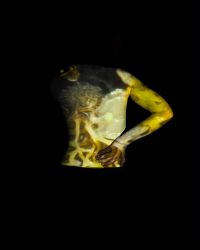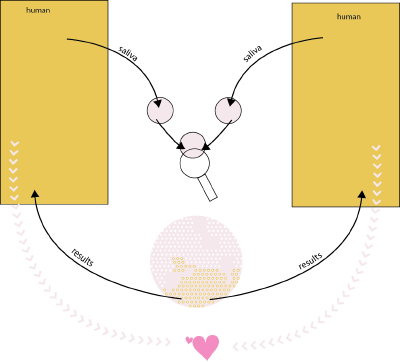(Created page with "BIO.MATCH (english/ german below) At the beginning, there is the fascination for the microbiome. The realization that bacteria are not fundamentally dangerous, but much mo...") |
(No difference)
|
Revision as of 16:55, 7 November 2018
BIO.MATCH
(english/ german below)
At the beginning, there is the fascination for the microbiome.
The realization that bacteria are not fundamentally dangerous,
but much more vital, also changes my view of things.
A previous work, purely visual without any scientific claim, is based on this new knowledge.
It shows projections of bacteria and fungal cultures that normally live invisibly on human skin.
The viewer should be made aware of what is happening on his body (see Fig.1).

The sciences surrounding the microbiome, which has been the focus of much research since 2007, are still in their infancy. It is assumed that a maximum of 1% of all existing bacteria is known, but not necessarily researched. In addition, there is a large number of amoebae, fungi, mites and often worms. It is known that the microbiome is composed differently in different parts of the body due to different milieus.
The focus of much research on the microbiome is on curing diseases. It is clear that "Staphylococcus aureus" influences the clinical picture of neurodermatitis and intestinal bacteria influence the psyche. In the animal world, one discovers at about the same time that hyenas can communicate with the help of bacteria in special glands and already much earlier one determines that (with women) the body smell of humans is much more important than each other body characteristic of humans with the partner search. This, in turn, is influenced by bacteria. I ask myself what we will be able to find out about the microbiome in the future. Which problems can be solved with new knowledge? The decisive impulse for my idea was the all-round talent of the microbiome. Not only the genetic basis and its ancestry influence his microbiome, but also current living conditions and habits, such as place of residence, mental state, and other sociographic factors.
If one were able to analyze all this and compare different people with each other,
one could make exact predictions about their compatibility with each other.
The dating service of the future would be created.
You can find more information (only in german) here!
Also, I created a DIY-Kit. I will bring it to the class on Friday.
The general idea can be described with this graphic:

- Two people give their sample.
- The microbiome of the two people is analysed from this sample.
- bio.match looks for similarities or indications of good compatibility.
- The result is communicated to the participants and
- they can decide whether they want to get to know each other.
For further examples have a look at BIO.MATCH-Instagram
At the moment this project is purely speculative.
But there is also a large scientific part in this work.
Over the last few, years I have done a lot of experiments to approach this topic.
Since I have no experience other than my school knowledge, I have tried to find out everything as well as possible
and have experienced countless failures.
In this project, I concentrated solely on saliva samples and tried to grow a particularly large number of microorganisms from them on various media.
I will be happy to show you my exact approach, results, improvement approaches and criticisms in our joint course or on request.
I don't want to put these things online because they contain many mistakes and can be misinterpreted.
The aim of this course is to achieve a more professional handling and workflow for me. Especially in the area of documentation and verifiability of results. In addition, I would like to discuss other methods with you and perhaps come again to a completely new approach to test a compatibility on a scientific level between people. For example the use of a sectrometer.
BIO.MATCH(german)
Zu Beginn steht die Faszination für das Mikrobiom. Die Erkenntnis,
dass Bakterien nicht grundsätzlich gefährlich sind, sondern viel mehr lebensnotwendig,
verändert meinen Blick auch die Dinge.
Eine vorhergehende Arbeit, rein visuell ohne wissenschaftlichen Anspruch,
basiert auf diesem neuen Wissen. Gezeigt werden Projektionen von Bakterien,
sowie Pilzkulturen, die normalerweise unsichtbar auf der Haut des Menschen leben.
Der Betrachter soll darauf aufmerksam gemacht werden, was auf seinem Körper vorgeht.(s. Abb.1)

Die Wissenschaften rund um das Mikrobiom, welches seit 2007 Mittelpunkt vieler Forschungen ist, stehen noch am Anfang. Man geht davon aus, dass maximal 1% aller existierenden Bakterien bekannt, aber nicht zwangsläufig erforscht ist. Hinzu kommen eine große Anzahl von Amöben, Pilzen, Milben, oft auch Würmern. Man weiß, dass sich das Mikrobiom an verschieden Körperstellen auf Grund verschiedener Milieus verschieden zusammensetzt.
Im Mittelpunkt vieler Forschungen am Mikrobiom steht die Heilung von Krankheiten. So steht fest, dass „Staphylococcus aureus“ das Krankheitsbild von Neurodermitis beeinflusst und Darmbakterien Einfluss auf die Psyche nehmen. In der Tierwelt entdeckt man etwa zeitgleich, dass Hyänen mit Hilfe von Bakterien in speziellen Drüsen kommunizieren können und schon viel früher stellt man fest, dass (bei Frauen) der Körpergeruch eines Menschen viel wichtiger ist als jedes andere Körpermerkmal des Menschen bei der Partnersuche. Dieser wird wiederum von Bakterien beeinflusst. Ich stelle mir die Frage was man in der Zukunft mit dem Mikrobiom in Erfahrung bringen kann. Welche Probleme kann man mit dem neuen Wissen lösen? Ausschlaggebender Impuls für meine Idee war schließlich das Allroundtalent des Mikrobioms. Nicht nur die genetische Grundlage und seine Abstammung beeinflussen sein Mikrobiom, sondern auch aktuelle Lebensumstände und Gewohnheiten, wie Wohnort, psychischer Zustand und andere soziografische Faktoren.
Wäre man fähig all dies zu analysieren und verschiedene Menschen miteinander zu vergleichen, könnte man genaue Vorhersagen über ihre Kompatibilität miteinander machen. Es entstände die Partnerbörse der Zukunft.
Du kannst mehr Infomationen zu dem Projekt hier
finden.
Ausserdem habe ich auch ein DIY-Kit kreiert. Ich werde es am Freitag mitbringen.
bio.match funktioniert wie folgt:

- Zwei Menschen geben ihre Probe ab.
- Aus dieser wird das Mikrobiom der beiden Personen analysiert.
- Es wird nach Gemeinsamkeiten oder Hinweisen auf eine gute Kompatibilität geschaut.
- Das Ergebnis wird den Teilnehmern mitgeteilt und
- diese können entscheiden, ob sie sich kennenlernen möchten.
Für weitere Informationen dieser Art schau auch auf den Instagram Account
Momentan ist dieses Projekt rein spekulativ. Aber es gibt auch einen großen wissenschaftlichen Anteil in dieser Arbeit. Ich habe über die letzten Jahre sehr viele Versuche und Experimente gemacht um mich diesem Thema anzunähern. Da ich ausser meinem Schulwissen keine weitere Erfahrung mitbringe, habe ich versucht alles so gut wie möglich in Erfahrung zu bringen und habe dabei unzahllose Fehlschläge erlebt.
Ich habe mich bei diesem Prjekt einzig auf Speichelproben konzentriert und versucht aus diesen auf verschiedensten Medien eine besonders große Anzahl von Mikroorganismen wachsen zu lassen. Ich zeige euch gerne meine genaue Vorhergehensweise, Resultate, Verbesserungsansätze und Kritiken in unserem gemeinsamen Kurs oder auf anfrage. Ich möchte diese Sachen nicht online stellen, weil sie viele Fehler enthalten und fehlinterpretiert werden können.
Ziel dieses Kurses ist für mich einen professionelleren Umgang bzw. Workflow zu erlangen. Vor allem im Bereich der Dokumentation und Prüfbarkeit der Ergebnisse. Ausserdem möchte ich gerne andere Methoden mit euch besprechen und vielleicht auch nochmal zu einem völlig neuen Ansatz kommen um eine Kompatibilität auf wissenschaftlicher Ebene zwischen Menschen zu überprüfen, zum Beispiel mit einem Spektrometer.